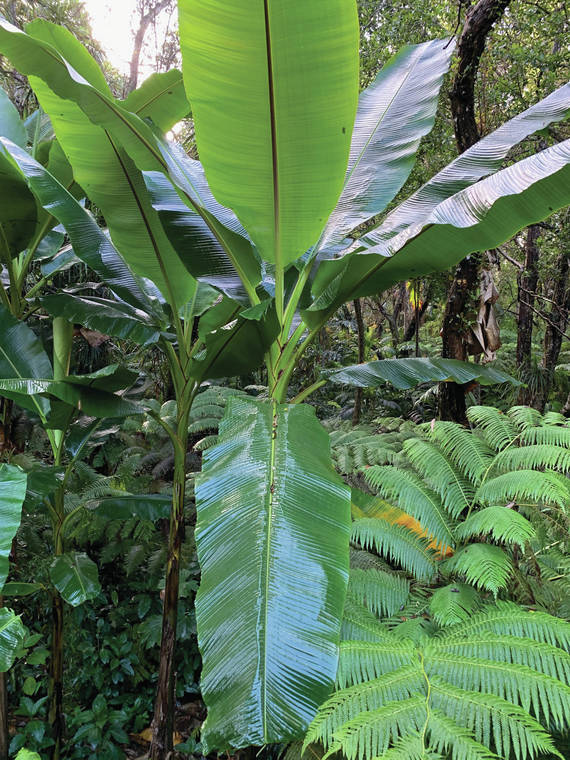Even though we talk a good story about being independent by growing our food and buying locally grown fruits and vegetables, it is not an easy thing to do. One exception is by growing and eating local bananas.
Farming for a living is tough. It is enough to drive you bananas, especially if you are a commercial banana grower in Hawaii. Our islands are ideally suited for producing good banana crops, but diseases like Panama wilt and bunchy top virus make it a real gamble. Fortunately, there are varieties that are resistant to Panama wilt. The early Polynesian voyagers brought over 50 varieties of banana to our islands. Sadly, many are more subject to disease than are the popular ones we grow now.
According to the Hawaii Banana Industry Association, there may be another way of beating diseases. John Hu, at the University of Hawaii College of Tropical Agriculture and Human Resources (CTAHR) and his team have worked to engineer virus resistant plants. This approach could also be used to build in resistance to other banana diseases. Another approach is to seek biological controls of the aphid that spread diseases from one plant to another. These are long term solutions. In the meantime, it is imperative that back yard gardeners make every effort to remove banana plants that show signs of diseases like bunchy top and Panama wilt. How can you tell if these diseases are present? The fruiting stems will not produce normal bunches.
If you have room in your garden you may grow this amazing plant, but be sure you get your starts from reliable sources free of diseases.
The four secrets to success with bananas begin with the soil first. Banana plants thrive best on good soils fairly rich in organic material, and in moist situations, provided the soil is well drained. They will grow in nearly any soil except one composed almost wholly of sand or rock. Bananas are seriously damaged by salt water and by high chloride accumulation in soils due to intrusion of brackish water in coastal areas.
The second secret is wind. The leaves are likely to be damaged by heavy winds thus plants should not be planted in an exposed location. Tattered leaves cannot function as well as entire leaves.
Third is that varieties are important. The dwarf variety Cavendish or Chinese is better adapted to small garden conditions as it has a short, stout stem from 4 to 7 feet tall, with broad leaves borne on short sturdy midribs. It is somewhat hardier and more wind resistant than taller varieties. The fruit is of medium size, thin skinned, and of good quality. Growing larger to 20 feet, the “Brazilian” banana is hardy and prolific, but not of as good quality. “Williams hybrid” is larger fruited than the other two and yet not as tall as the apple. It is superior for home gardens and is grown commercially. Other less known varieties with potential are “Cuban red,” “dwarf Jamaican,” and the “thousand finger” of Indonesia. The Chinese will also do better where temperatures on the chilly side than other varieties.
Fourth is fertilization. Banana plants are heavy feeders and respond well to fertilization. Most Hawaiian soils are deficient in the major elements, nitrogen, phosphorus and potassium, and may be deficient in the elements, magnesium, calcium, copper and zinc. Bananas require all of them. As a general rule, bananas will thrive on the fertilizer mixtures shown by experience to be necessary on other crops grown on each particular soil type. The amounts required will also vary with the various soil types. Since the bananas are heavy and constant feeders, results usually will be better from frequent light applications than from infrequent heavy applications. Mulches, compost and manures greatly benefit the plants as well.
While the plants are young it is best to remove all suckers but one. This will force strength into the flowering stalk and leave one to take its place after fruiting. This way, larger bunches of fruit can be expected. Later, when the mat has matured, from three to five stalks may be allowed to grow if well spaced. Bananas harvested seven to 14 days before ripening and hung in a shady, cool place on the bunch will develop their flavor and nutritive value better than if allowed to ripen on the plant.
Bananas are hardy as far as pests are concerned. Occasional sprays of fungicides may be needed to keep leaves and fruit free of streaking or spotting fungus organisms. Be sure to read and follow manufacturers directions on the label.
The main disease problem to avoid besides bunchy top is Panama wilt. Bluefield bananas are susceptible as are several Hawaiian varieties. If the disease is present, plant resistant varieties like Williams and Cavendish, since there is no economic cure for the disease.
This information and more is available from the University of Hawaii College of Tropical Agriculture and Human Resources.


